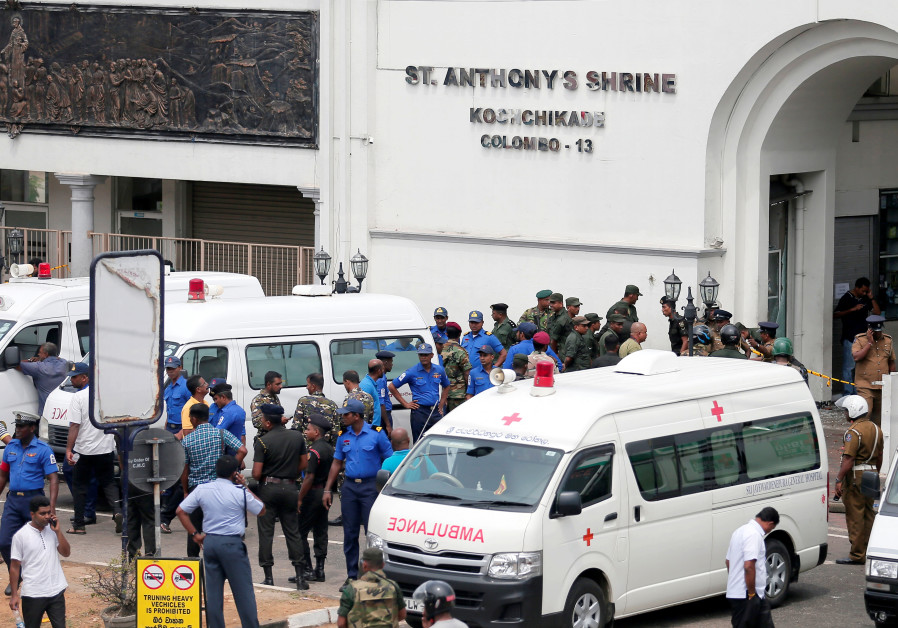It is hallmark of our era that when it comes to mass murder and coordinated terror attacks that we have a long list to choose from when looking at past experiences.
Seth J. Frantzman

A coordinated series of attacks on churches and hotels in Sri Lanka conjures up memories of previous terror attacks. In striking at worshippers at prayer it reminds us of the Christchurch mosque shootings on March 15. It also appears linked to previous Easter terror attacks, including the one on Palm Sunday in Egypt in 2017 that murdered 45 and the Lahore Eastern terror attacks that killed 75 in 2016. In coordination and the number of sites chosen it is also similar to the 2008 Mumbai attacks that killed 166.
It is hallmark of our era that when it comes to mass murder and coordinated terror attacks that we have a long list to choose from when looking at past experiences. In the last decades the growing number of terror attacks, most carried out by far-right Islamist extremists, with others perpetrated by white nationalists and other groups, has become an almost daily event. Last week gunmen murdered fourteen people in western Pakistan in an attack on Pakistani security forces allegedly carried out by terrorists from Iran. Earlier in April a bombing in Quetta targeted Shi’ites and was allegedly carried out by Islamic State. The attack wasn’t widely reported outside Pakistan. And there was an attack on Friday in Kabul against government institutions.
Not all attacks are the same, the ones in Pakistan and Afghanistan specifically struck at the military and government. The one in Quetta targeted minorities. But there are methods that are similar and there are networks of groups that learn from eachother, specifically ISIS and its affiliates. ISIS has built upon decades of experience gained from Al Qaeda, and other groups who perfected their murderousness.
The full picture of the Sri Lankan attacks is not clear. Pakistan’s spokesman for its Ministry of Foreign Affairs released a statement in the afternoon condemning the “terrorist attacks in Sri Lanka.” Pakistan says it stands with Sri Lanka.
Sri Lanka has a long history fighting terrorism, but it was generally fighting against Liberation Tigers of Tamil Eelam, a separatist movement that was largely defeated in 2009. The Tamil fighters were rooted in the Tamil Hindu minority of the Buddhist majority Sri Lanka. Christians make up only around eight percent of the country and Muslims an additional 12 percent. In 2016 Sri Lanka revealed that thirty-two Sri Lankans had joined ISIS and left the country. Many were said to be from educated families, something that surprised authorities. The local Muslim community condemned the government’s statements as “tarnishing the image” of Sri Lankan Muslims. An Australian member of ISIS was similarly shown to have a respected uncle back home in Sri Lanka. Other reports indicated ISIS members in India had connections to Sri Lanka and there were concerns after the defeat of ISIS about ISIS returnees. This appears similar to the process of extremism in Bangladesh before the 2016 Dhaka attack which was carried out by educated ISIS perpetrators and targeted foreigners in a café.
While Easter attacks are carried out by Islamist extremist groups, including the ones mentioned above in Pakistan and Egypt, and an attack in Iraq in 2011, the complex and coordinated nature of the attack in Sri Lanka looks more like the attacks in Mumbai in 2008. In that year twelve coordinated bombing and shooting attacks struck across Mumbai, including at a Café, the Taj Mahal Palace Hotel, the Oberoi Trident hotel, and a Jewish Chabad house. That attack was coordinated by Lashkar-e-Taiba in Pakistan. Unlike the bombings in Sri Lanka, the attack was carried out by gunmen.
The attacks in Sri Lanka struck three churches. This included St. Sebastian’s Church in Negombo, St. Anthony’s Shrine in Colombo and Batticaloa’s Zion Church, according to The Dawn. Police initially estimated only twenty killed but soon had revised that to more than 100 with 45 murdered in Colombo, 25 in Batticaloa, and 67 in Negoombo. Three major hotels were struck in Colombo, all of them in a line along a major road that links several important central districts of the city. These included the Cinnamon Grand, Shangri-La and Kingsbury.
According to reports police chief Pujuth Jayasundara had warned on April about a threat of attacks on Churches and targeting the Indian High Commission office. That office is near the hotels that were targeted. In his security notice he had pointed to a local Islamic group as planning the attacks. But it isn’t entirely clear if the police chief was convinced there was a threat was security increased before Easter, which would have been the most high profile holiday coming up?
After the attack in New Zealand there has been heightened awareness of the threat of attacks on religious institutions and people at prayer. The outpouring of support in the wake of that attack is a lesson for the kind of support Sri Lanka will now need. If the death toll is as high as initial reports indicate the attack is one of the worst of its kind in recent memory. But these kinds of attacks have become more normal in recent years. Governments have not found a way to prevent them, even with the latest technology and intelligence sharing.
Content retrieved from: https://www.jpost.com/International/Sri-Lanka-terror-has-hallmarks-of-previous-attacks-587479?fbclid=IwAR1ZnwzncZ9k4nKF5mBhn5G5nMVJWFT-h4A_Hw1s_t5qRoGOHU-FzLl9a_A.